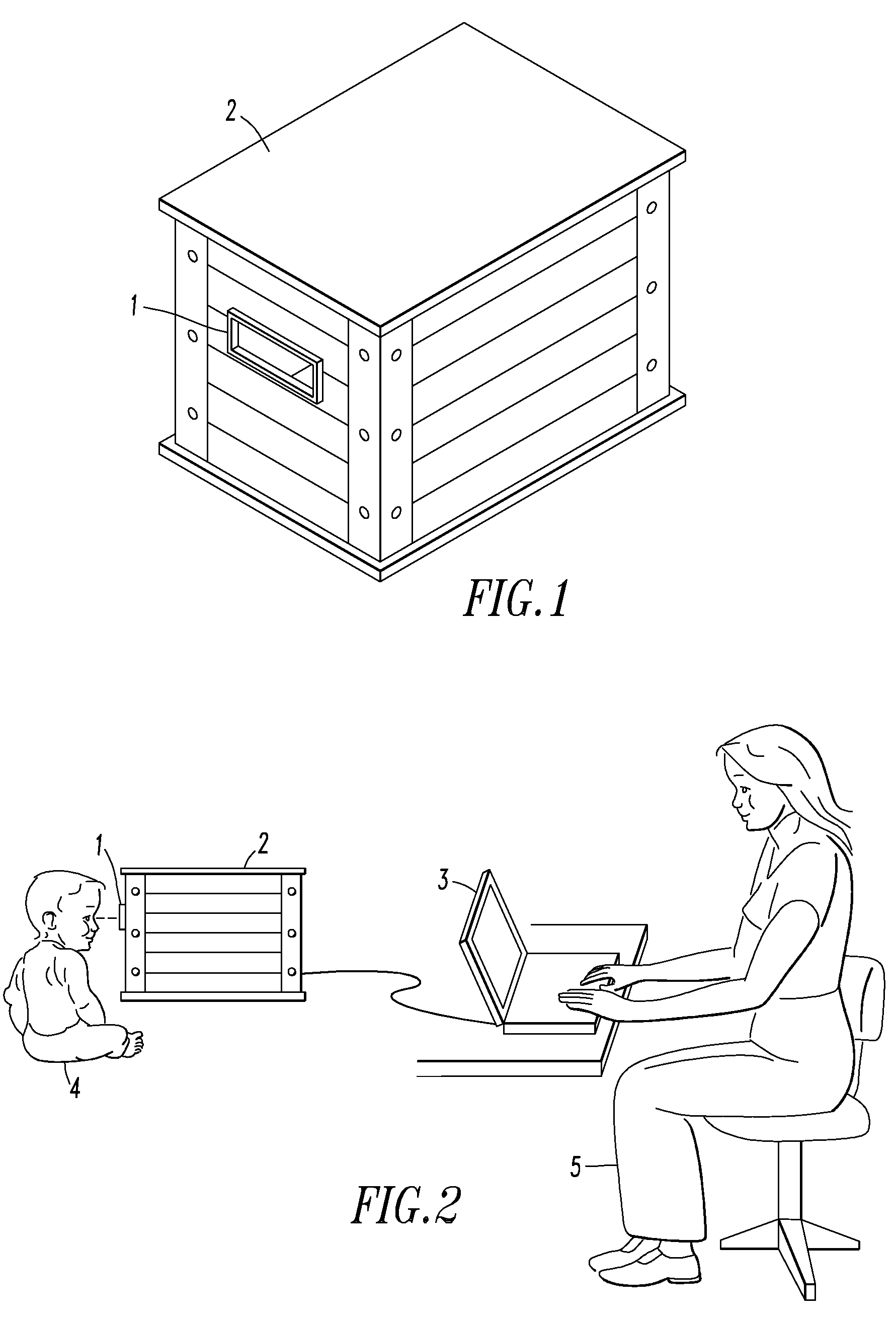Vision Screener
a technology of vision and article, applied in the field of vision screening, can solve the problems of non-verbal persons, difficult diagnosis of non-verbal persons, stroke victims, infants, etc., and achieve the effect of reducing the number of people who cannot see clearly, reducing the difficulty of diagnosis, and improving the quality of li
- Summary
- Abstract
- Description
- Claims
- Application Information
AI Technical Summary
Problems solved by technology
Method used
Image
Examples
example 1
[0090]A person's eyes were tested using the method and article of the invention. The article included an enclosure defining an aperture. The enclosure was configured to appear as a treasure chest. The article comprised components including an attention getting device, an image capture device, a test light, a processing unit, an input device, a printer, and a display. Conveniently, the attention getting device, the image capture device, the test light, the processing unit, and the printer were contained within the enclosure. An operator entered the person's name using a keyboard input device. The operating program permitted as many as twenty-five characters as either text, numbers or special characters. The operator entered the person's birth date in the format mmddyy where mm is the month, dd is the day and yy is the year of the birth date. Pressing the [Esc] key permitted correction of any mis-entries. The display was an LCD monitor and the display projected the person's name, birt...
example 2
[0091]A person's eyes are examined using the following method. The method begins when the person's eyes look into an aperture. The aperture is large enough to allow the person to assume a wide range of viewing positions such that the person is not constrained to a fixed or forced position. The method includes:[0092]a. capturing a plurality of images of the person's eyes when presented at the aperture;[0093]b. verifying that captured images include both eyes of the person;[0094]c. studying a plurality of verified images to calculate and present findings of strabismus indicators, opacity indicators, refractive errors, or other defects in the person's eyes; and[0095]d. evaluating the studied images to determine and present the study findings as normal, abnormal, or inconclusive, and to present an indication if the person should be referred for a follow-up examination by an ophthalmologist or other vision professional.
example 3
[0096]A method for capturing images begins when a person looks into the aperture of an enclosure. The method includes the following steps:[0097]a. activating an attention getting device;[0098]b. testing the light level to ensure the presence of a person at the aperture;[0099]c. allowing an interval of time, typically from about 1 to 3 seconds, to pass so that the timing of the remaining steps will be unpredictable to the person;[0100]d. activating a test light, optionally filtered to produce light in a limited frequency range, for a time period shorter than the person's pupillary response time and at an intensity bright enough to produce photorefraction in an image of the person's eyes;[0101]e. activating an image capture device, while the test light is activated, to capture the image present at the aperture;[0102]f. transferring the captured image to a processing unit for verification; and[0103]g. deactivating the attention getting device.
PUM
 Login to View More
Login to View More Abstract
Description
Claims
Application Information
 Login to View More
Login to View More - R&D
- Intellectual Property
- Life Sciences
- Materials
- Tech Scout
- Unparalleled Data Quality
- Higher Quality Content
- 60% Fewer Hallucinations
Browse by: Latest US Patents, China's latest patents, Technical Efficacy Thesaurus, Application Domain, Technology Topic, Popular Technical Reports.
© 2025 PatSnap. All rights reserved.Legal|Privacy policy|Modern Slavery Act Transparency Statement|Sitemap|About US| Contact US: help@patsnap.com



